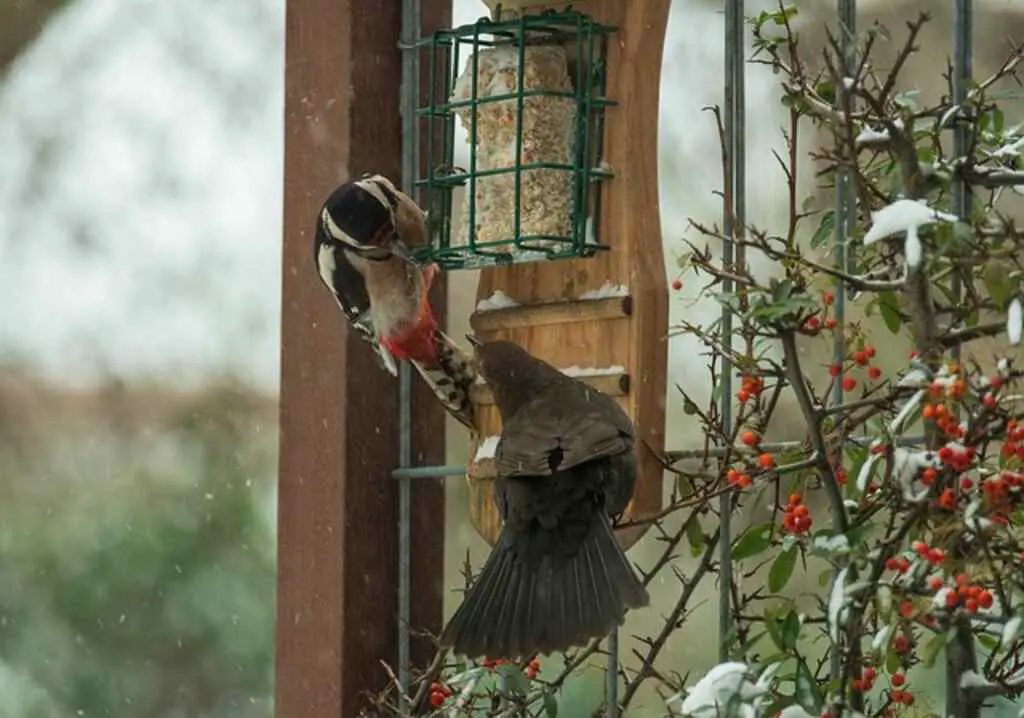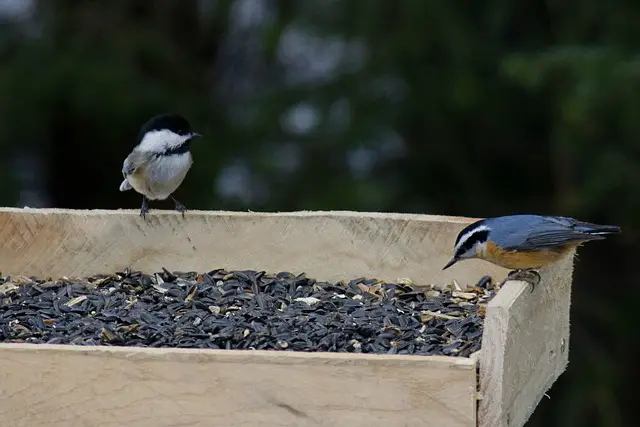Discovering the joys of backyard bird feeding can be a delightful experience, but it’s essential to avoid common mistakes that could deter birds or harm their health. In this guide, we’ll explore the top 10 mistakes to steer clear of, ensuring your feathered visitors are happy, healthy, and frequent guests in your backyard oasis.
Table of Contents
- 1 Common Backyard Bird Feeding Mistakes
- 1.1 Mistake #1: Inappropriate Bird Feeder for Bird Type
- 1.2 Mistake #2: Incorrect Bird Feeder Seed Selection
- 1.3 Mistake #3: Placing your Bird Feeder in the Wrong Location
- 1.4 Mistake #4: Overcrowding your Bird Feeder
- 1.5 Mistake #5: Dirty and Contaminated Bird Feeders
- 1.6 Mistake #6: Ignoring Seasonal Changes in Bird Feeding Habits
- 1.7 Mistake #7: No Water Source for Birds to Drink and Bathe
- 1.8 Mistake #8: Ignoring Potential Predators and Safety Hazards
- 1.9 Mistake #9: Neglecting Regular Bird Feeder Maintenance
- 1.10 Mistake #10: Inappropriate Bird Feeding Practices
- 2 Conclusion
- 3 Author
Common Backyard Bird Feeding Mistakes
Mistake #1: Inappropriate Bird Feeder for Bird Type
The Importance of Choosing the Right Bird Feeder
Choosing the right bird feeder for the birds in your backyard is crucial to their health and well-being. Different birds have different feeding preferences, so it’s important to choose a feeder that meets their specific needs.
If you choose the wrong type of feeder, you may end up attracting birds that don’t belong in your area or that can’t use the feeder effectively, which can be harmful to their health.
Common Types of Bird Feeders
There are several common types of bird feeders, including tube feeders, hopper feeders, suet feeders, and platform feeders. Each type of feeder is designed to attract a specific group of birds and provides a different type of food.
Choosing the Right Feeder for Different Bird Species
Different bird species have different feeding preferences, so it’s important to choose a feeder that’s appropriate for the birds in your area.
For example, tube feeders are great for attracting small birds like finches, while hopper feeders are better suited for larger birds like cardinals and jays.
Suet feeders are ideal for woodpeckers and nuthatches, while platform feeders can attract a variety of bird species.
Backyard Bird Information Tool
Use this tool to learn more about common backyard birds. Select a species from the drop-down menu to see information about the proper feeder and food type, as well as some interesting facts about the bird.
| Feeder | |
|---|---|
| Food | |
| Facts |
Risks of Choosing the Wrong Feeder
Choosing the wrong feeder can have several risks. For example, if you choose a tube feeder that’s too small for the birds in your area, they may not be able to access the food, which can lead to starvation.
Similarly, if you choose a feeder that’s too large, it can attract unwanted bird species that may carry diseases or compete with the native bird species for food.
How to Choose the Right Bird Feeder
To choose the right bird feeder, consider the bird species in your area and their feeding preferences. Also, consider the location of the feeder, as well as the type of food you plan to offer.
It’s important to choose a feeder that’s sturdy and easy to clean, as this can help prevent the spread of disease.
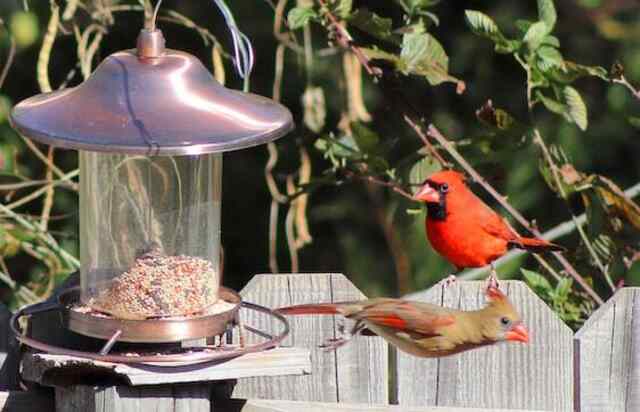
Mistake #2: Incorrect Bird Feeder Seed Selection
Bird feeding is a great way to attract a variety of bird species to your backyard, but one of the most common mistakes is filling your bird feeder with the wrong type of seed. This can have negative impacts on the health of the birds and the environment.
In this section, we will explore this mistake in detail, including the types of seeds that are harmful to birds and the proper seed selection process.
Types of Seeds that are Harmful to Birds
Not all bird seeds are created equal. In fact, some seeds can be harmful to birds, particularly if they are not appropriate for the species in your area. One of the most common mistakes is filling your feeder with seed mixes that contain fillers such as milo, red millet, and cracked corn.
These seeds are often used as cheap fillers, but have very little nutritional value for birds. Birds may consume them, but they will not receive the nutrients they need to maintain good health. Another harmful type of seed is treated seed.
Treated seed is coated with chemicals such as pesticides or fungicides, which can be toxic to birds if ingested. The chemicals can also leach into the environment and harm other wildlife or contaminate the soil.
Proper Seed Selection Process
To avoid the mistake of filling your feeder with the wrong type of seed, it is important to understand the proper seed selection process. The first step is to research the types of birds in your area and their preferred seeds.
This information can be found in bird guides or online resources. Once you know the preferred seeds of the birds in your area, it is important to purchase high-quality seed that is free of fillers and chemicals.
Look for seed mixes that contain a variety of seeds, such as black oil sunflower seeds, nyjer, and safflower seeds. These seeds are high in protein, oil, and other nutrients that birds need to maintain good health.
Read more: How Much Birdseed Can A Bird Eat Per Day? Expert Guide!

Mistake #3: Placing your Bird Feeder in the Wrong Location
Birds can be quite picky about where they feed, and the location of your bird feeder can play a big role in determining whether or not it attracts the birds you want to see.
Placing your bird feeder in the wrong location can also lead to health problems for birds and other issues. These are mistakes that are commonly made and should be avoided:
Placing the feeder too close to windows
Placing your bird feeder too close to windows can be a mistake for a few reasons. Firstly, birds can become disoriented by reflections in the glass, and can fly into the window and injure themselves.
Secondly, if you place your bird feeder too close to a window, birds can become confused by the reflection of the feeder and the seed, and may have trouble finding the exit.
Lastly, predators like cats can easily ambush birds that are feeding close to a window.
Placing the feeder too close to the ground
A common mistake is to place the bird feeder too close to the ground. This can make it easier for predators like cats and raccoons to get at the feeder and the birds.
In addition, placing the feeder too low can make it difficult for birds to see the feeder and find the food. Ideally, the feeder should be at least four to five feet off the ground.
Placing the feeder in a location that is too exposed
Birds need cover and protection when they are feeding, so placing the feeder in a location that is too exposed can be a mistake. Birds are more likely to use the feeder if it is located near trees, shrubs or other natural cover.
In addition, birds are more likely to use a feeder that is located in a location that is sheltered from the wind and other harsh weather conditions.
Placing the feeder too close to other bird feeders
Placing your bird feeder too close to other bird feeders can lead to competition between birds. This can be a problem if you are trying to attract a specific type of bird to your feeder. In addition, having multiple feeders in close proximity can increase the spread of diseases among the birds.
Placing the feeder too close to a bird bath or water source
While it may seem like a good idea to place your bird feeder close to a bird bath or water source, this can actually lead to health problems for the birds. Birds can carry bacteria and diseases, and having the feeder too close to a water source can increase the spread of these diseases.
In addition, birds may be scared away from the feeder if they feel too exposed or vulnerable while drinking from the water source. By avoiding these common mistakes and placing your bird feeder in the right location, you can attract the birds you want to see and help keep them safe and healthy while they are feeding.
Read more: How to Set up a Bird Feeder in your Yard? (Easy Guide)
Mistake #4: Overcrowding your Bird Feeder
Bird feeders are a wonderful way to attract a variety of bird species to your backyard. However, many bird enthusiasts make the mistake of overcrowding their bird feeder in an attempt to attract more birds.
Unfortunately, overcrowding can lead to a number of problems that can harm the birds and decrease the effectiveness of your feeding efforts.
Problem 1: Increased competition for food
When you overcrowd your bird feeder, you increase the competition for food among the birds. This can lead to aggressive behaviors such as fighting and bullying, which can harm the weaker birds and prevent them from accessing the food.
In addition, overcrowding can lead to the spread of diseases among the birds, as they come into closer contact with each other.
Problem 2: Wasted food
When there are too many birds at the feeder, they tend to waste more food. Birds will often take a mouthful of seed and then fly away to eat it elsewhere.
This not only wastes seed, but it can also lead to the buildup of seed shells and debris around your feeder, which can attract pests and make cleaning more difficult.
Problem 3: Maintenance issues
An overcrowded bird feeder can also lead to maintenance issues. With so many birds coming and going, the feeder may need to be refilled more frequently, and the buildup of seed shells and debris may require more frequent cleaning. This can be time-consuming and may discourage you from continuing to feed the birds.
Solution: Space out your bird feeders
The solution to overcrowding is simple: space out your bird feeders. By placing multiple feeders in different areas of your backyard, you can attract more birds without overcrowding any one feeder. This will decrease the competition for food, reduce the spread of diseases, and decrease the amount of wasted seed.
In addition to spacing out your feeders, you can also use different feeder types to attract different types of birds. For example, tube feeders are great for small songbirds, while hopper feeders are better for larger birds such as cardinals and jays.
By using a variety of feeder types, you can attract a wider range of bird species to your backyard.
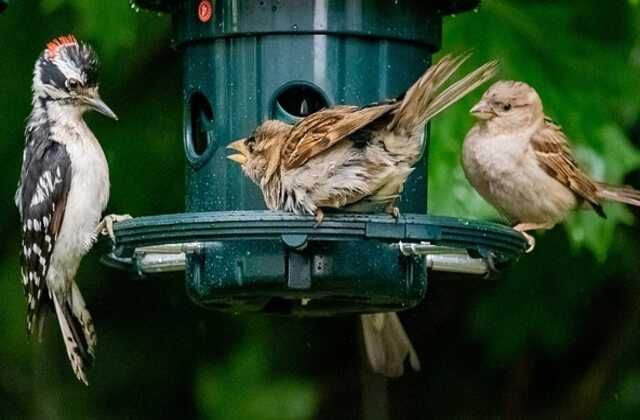
Mistake #5: Dirty and Contaminated Bird Feeders
As a backyard bird feeder, it’s essential to keep your feeder clean to prevent diseases from spreading to the birds. Feeding birds with a dirty and contaminated feeder is a mistake that can harm the birds and ultimately result in their deaths.
When birds feed, they drop seeds and other food particles, leaving a mess in and around the feeder. The leftover food particles and fecal matter attract bacteria, fungi, and other microorganisms that can cause diseases such as salmonella, aspergillosis, and avian pox.
Therefore, it’s crucial to clean your feeder regularly to prevent the buildup of these disease-causing agents.
Here are some important steps to take to avoid this common bird feeding mistake:
- Clean your feeder regularly: Clean your feeder at least once a week, or more often if you notice a buildup of debris. Start by removing any leftover food and then use soap and water to scrub the feeder. Rinse it thoroughly with clean water and allow it to dry completely before refilling it.
- Disinfect the feeder: Once you have cleaned the feeder, use a disinfectant to kill any remaining bacteria or fungi. A bleach solution of one part bleach to nine parts water is a useful disinfectant. Make sure to rinse the feeder thoroughly with clean water after disinfecting it.
- Clean the feeding area: The area around the feeder can also become contaminated with bird droppings and leftover food particles. Clean the feeding area regularly with soap and water and disinfect it with a bleach solution to prevent the buildup of disease-causing agents.
- Practice good hygiene: It’s essential to practice good hygiene when handling bird feeders and birdseed. Wash your hands thoroughly before and after filling the feeder to prevent the spread of diseases.
By following these simple steps, you can ensure that your bird feeder remains clean and free from contaminants. By doing so, you’ll be helping to protect the birds and ensuring that they continue to visit your feeder for years to come.
Mistake #6: Ignoring Seasonal Changes in Bird Feeding Habits
Bird feeding is a popular activity enjoyed by millions of people worldwide. However, one common mistake that bird enthusiasts often make is ignoring the seasonal changes in bird feeding habits. Failing to recognize these changes can lead to a variety of problems for both the birds and the bird feeders.
In this section, we will explore the importance of understanding seasonal changes in bird feeding habits, and the steps you can take to avoid making this mistake.
Importance of Seasonal Changes in Bird Feeding Habits
Bird feeding is not a one-size-fits-all activity. Different bird species have varying feeding habits, and these habits can change depending on the season. For example, during the winter months, birds need high-fat, high-energy foods to help them survive the cold weather.
In contrast, during the spring and summer months, birds require more protein and fresh fruits and vegetables to support breeding and nesting activities. Ignoring these seasonal changes in bird feeding habits can have serious consequences for both the birds and the bird feeders.
If you provide the wrong type of food at the wrong time of year, you may inadvertently attract the wrong type of bird, which can lead to aggressive behavior and competition for resources.
Additionally, feeding birds the wrong type of food can also lead to nutritional imbalances, which can have negative impacts on their health.
Tips for Bird Feeding During Seasonal Changes
To avoid making this mistake, it is essential to understand the feeding habits of the bird species in your area and the seasonal changes that affect those habits. Research the types of birds that frequent your backyard and their dietary preferences.
Some birds, like finches, prefer seeds, while others, like hummingbirds, require nectar. Knowing these preferences will help you choose the right type of food to offer at the right time of year. It is also important to monitor your bird feeders regularly and adjust the type of food you offer as needed.
During the winter months, for example, you may want to offer high-fat foods like suet cakes, which provide birds with the energy they need to survive the cold weather.
In the spring and summer, you may want to switch to fresh fruits and vegetables or protein-rich foods like mealworms to support breeding and nesting activities.
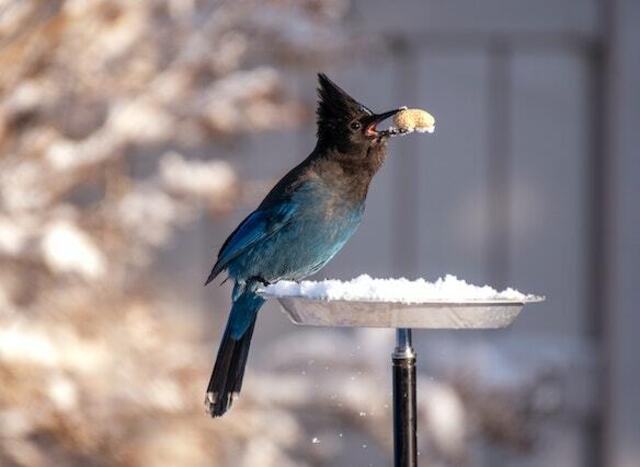
Mistake #7: No Water Source for Birds to Drink and Bathe
Water is essential for birds not just to drink, but also to maintain their feathers in good condition. Feather maintenance is crucial because feathers provide insulation, enabling birds to keep warm in cold weather and cool in hot weather. Additionally, feathers help birds fly and escape predators.
Why Providing Water Is Important
During winter, many natural sources of water freeze over, making it difficult for birds to find water to drink. In summer, water sources may dry up due to heat and drought.
Providing water in your backyard can help birds survive during these challenging times. Moreover, water is necessary for birds to bathe in.
Bathing helps birds remove dirt and parasites from their feathers, which can affect their insulation and flying ability if left unattended. Bathing also helps birds cool off in hot weather.
Common Mistakes
The most common mistake people make when providing water for birds is to use a bird bath that is too deep. A deep bird bath may make it difficult for small birds to use it, and they may end up drowning.
Instead, choose a bird bath that is shallow enough for birds to stand in and not more than two inches deep.
Another mistake is to place the bird bath in an area that is too exposed, such as under direct sunlight or near a bird feeder.
Birds may be hesitant to use the bath if they feel exposed to predators. Instead, place the bird bath in a shady area, preferably near bushes or trees, where birds can quickly escape if they sense danger.
Best Practices
To provide the best water source for birds, choose a shallow bird bath that is made of a material that is easy to clean, such as concrete or plastic. The bird bath should have a rough surface that allows birds to grip it while bathing.
Additionally, the water should be changed regularly to prevent the growth of bacteria and mosquitoes. If you live in an area where temperatures drop below freezing, consider investing in a bird bath heater to prevent the water from freezing.
In summary, providing water for birds to drink and bathe in is essential for their survival and health. By avoiding common mistakes and following best practices, you can help birds thrive in your backyard.
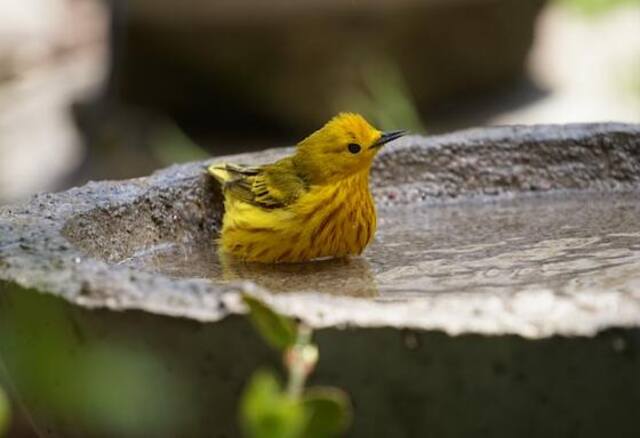
Mistake #8: Ignoring Potential Predators and Safety Hazards
Bird feeding can attract a variety of predators, including domestic cats, squirrels, raccoons, and birds of prey. Ignoring potential predators and safety hazards can harm birds and disrupt the ecosystem. In this section, we will explore the potential dangers of bird feeding and discuss how to minimize risks.
- Domestic cats: Domestic cats are one of the biggest threats to birds. According to a study conducted by the Smithsonian Conservation Biology Institute, domestic cats kill an estimated 2.4 billion birds each year in the United States alone. If you have a cat, make sure it wears a bell collar or keep it indoors to prevent it from hunting birds.
- Squirrels and raccoons: Squirrels and raccoons are notorious for raiding bird feeders. They can consume large quantities of birdseed and damage feeders in the process. To prevent squirrels and raccoons from accessing your feeder, place it on a pole or install a squirrel-proof feeder. Also, keep the ground around the feeder clean to avoid attracting raccoons.
- Birds of prey: Birds of prey, such as hawks and owls, may view your feeder as a hunting ground. While it is natural for them to hunt, it can be distressing to witness a hawk or owl catching a bird at your feeder. To minimize the risk of predation, place your feeder near shrubs or trees to provide cover for smaller birds to escape. Also, avoid placing the feeder near open spaces or tall structures that can provide a hunting perch for birds of prey.
- Disease transmission: Bird feeders can become breeding grounds for bacteria and viruses that can cause diseases. To prevent the spread of disease, clean your feeder regularly with soap and water, and disinfect it with a solution of one part bleach to nine parts water. Also, avoid overcrowding the feeder to reduce the risk of spreading diseases.
- Window collisions: Birds can collide with windows, especially if they are reflective or transparent. To prevent window collisions, place your feeder at least 30 feet away from windows or apply decals or tape to the glass to make it more visible to birds.
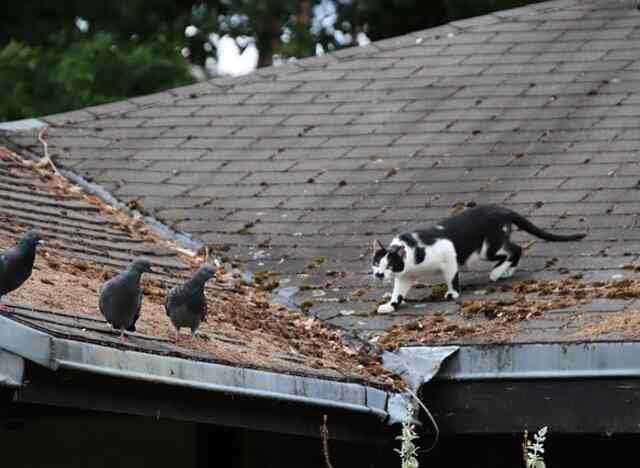
Mistake #9: Neglecting Regular Bird Feeder Maintenance
Bird feeders are an essential part of backyard bird feeding, providing a convenient source of food for our feathered friends. However, maintaining bird feeders is crucial to their effectiveness and the health of the birds that rely on them. Neglecting to clean and maintain your bird feeder regularly can lead to a host of problems that can be harmful to birds and their environment.
The importance of cleaning your bird feeder
A dirty bird feeder can harbor bacteria, fungi, and mold, which can cause disease and illness in birds. These microorganisms thrive in damp and dark conditions, making bird feeders an ideal breeding ground. Bird droppings and seed debris can also accumulate, attracting insects and rodents that can further spread disease.
Cleaning your bird feeder regularly is essential to prevent the buildup of harmful microorganisms and pests. It is recommended to clean your bird feeder at least once a month, or more frequently if necessary.
How to clean your bird feeder
Cleaning your bird feeder is a relatively simple process that requires only a few tools and materials. You will need a bucket, a brush, mild soap, and water. First, empty the feeder of any remaining seed and debris. Then, disassemble the feeder and soak the parts in warm, soapy water for several minutes. Use a brush to scrub the inside and outside of the feeder, paying special attention to any crevices or hard-to-reach areas.
Rinse the feeder thoroughly with clean water and allow it to dry completely before reassembling and refilling it with fresh seed. It is essential to clean the area around the feeder as well, as seed debris and droppings can accumulate and attract pests.
Maintaining your bird feeder
Regular maintenance of your bird feeder can extend its lifespan and ensure its effectiveness. Check the feeder for damage or wear and tear, as this can affect its ability to function correctly. Replace any damaged parts or repair the feeder as needed.
It is also essential to monitor the seed level in your feeder regularly. An empty feeder can deter birds from visiting your yard, while a full feeder can attract unwanted pests. Refill your feeder as needed, and store any extra seed in a dry and cool place.
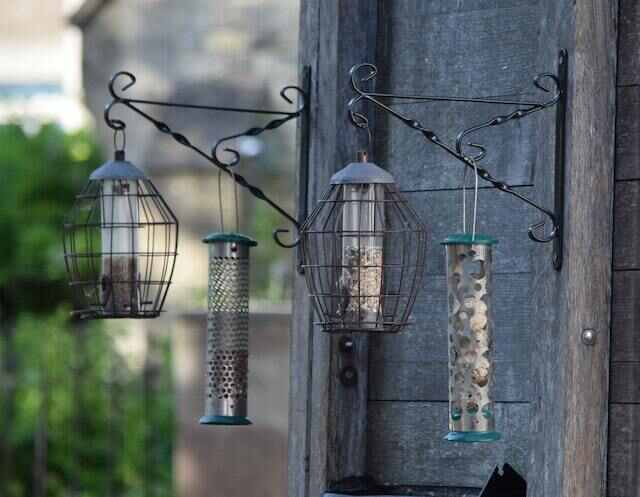
Mistake #10: Inappropriate Bird Feeding Practices
Feeding birds can be a rewarding and enjoyable experience, but it’s important to ensure that the food provided is suitable for the species and won’t cause harm. One of the biggest mistakes people make when feeding birds is offering them inappropriate human food or relying solely on birdseed. In this section, we’ll explore the potential risks of feeding birds these types of foods and offer alternatives that are safer and more nutritious.
The Dangers of Inappropriate Human Food
Birds have specific dietary needs that vary depending on their species, and feeding them inappropriate human food can lead to a range of health problems. For example, bread and other processed foods are often high in salt and sugar, which can cause dehydration, obesity, and even kidney damage in birds. Chocolate and caffeine are also toxic to birds and can cause heart problems, seizures, and death.
In addition to the potential harm to individual birds, feeding inappropriate human food can also have negative consequences for the environment. Birds that become reliant on human food may stop foraging for natural food sources, leading to a disruption in the ecosystem. Leftover food can also attract unwanted pests like rats and squirrels, which can damage crops and spread disease.
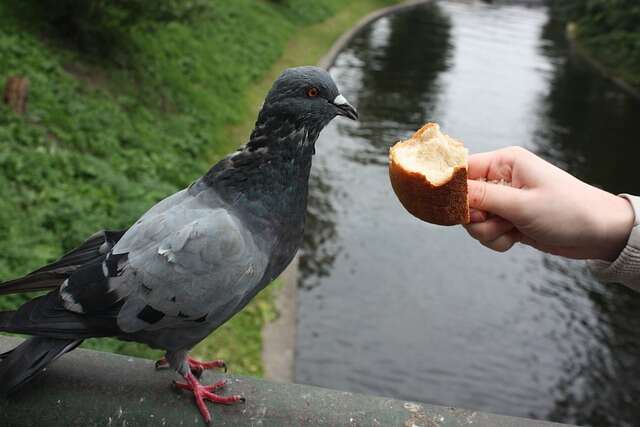
| Food | Why you should not feed it to birds | Alternative bird-friendly food |
|---|---|---|
| Bread | Lack of nutrients, may cause health problems and attract pests | Suet, mealworms, birdseed mix |
| Chocolate | Toxic to birds, can cause seizures and death | Berries, sliced fruits |
| Salty snacks | Excessive salt intake can cause dehydration and kidney damage | Nuts, unsalted seeds |
| Milk and dairy | Birds are lactose intolerant and cannot digest dairy products | High-protein seeds, insects |
| Avocado | Contains persin, which is toxic to birds and may cause heart damage | Berries, sliced fruits |
| Raw or dry beans | Contain toxins that can be harmful or fatal to birds | Grains, cooked legumes |
| Fruit pits and seeds | Can be toxic or cause digestive blockages | Chopped fruits, berries |
| Junk food | Lack of nutrients, high in fat and salt, can cause health problems | Birdseed mix, suet |
The Limitations of Birdseed
While birdseed is a popular choice for bird feeding, relying solely on this type of food can also be problematic. Many types of birdseed are high in carbohydrates and low in protein, which can lead to malnutrition and disease. Additionally, birdseed may not be suitable for all bird species, and some birds may not recognize it as food.
Fortunately, there are alternatives to inappropriate human food and birdseed that can provide birds with the nutrients they need. Offering a variety of fruits, vegetables, and live foods like mealworms can help provide a more balanced diet. It’s also important to research the dietary needs of the specific bird species you’re feeding to ensure that the food offered is appropriate.
Conclusion
In conclusion, attracting birds to your backyard can be a rewarding and enjoyable experience. However, it is important to be aware of the top 10 bird feeding mistakes to avoid causing harm to the birds. To recap, these mistakes include:
- Using pesticides and insecticides
- Offering spoiled or contaminated food
- Overfilling or underfilling bird feeders
- Using low-quality bird feed
- Not offering a variety of bird feeders
- Placing bird feeders in unsafe locations
- Not providing a source of water
- Not cleaning bird feeders regularly
- Allowing cats and other predators to harm birds
- Feeding birds inappropriate human food or relying solely on birdseed
To avoid these mistakes, it is important to provide a safe and healthy environment for birds. This can be achieved by offering a variety of bird feeders with high-quality bird feed, placing feeders in safe locations away from predators, providing a source of water, regularly cleaning bird feeders, and avoiding feeding birds inappropriate human food.
By following these tips, you can create a bird-friendly environment that attracts a variety of species to your backyard. Enjoy the beauty and wonder of these fascinating creatures while also helping to protect their well-being.
Related Post: How to Create a Bird-friendly Backyard? (An Easy Guide!)

